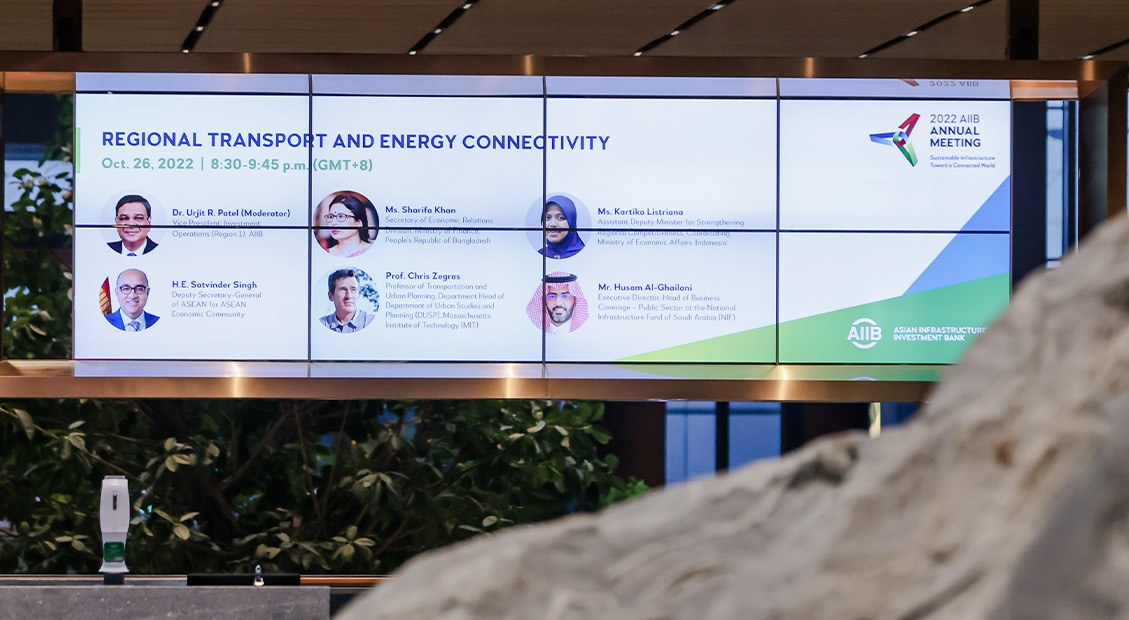“Strong intra- and interregional connectivity not only accelerates trade but also contributes to accelerated income and reduced poverty,” said Sharifa Khan, Secretary, Economic Relations Division, Bangladesh Ministry of Finance as she opened the session on “Regional Transport and Energy Connectivity” at the 2022 Asian Infrastructure Investment Bank (AIIB) Annual Meeting of the Board of Governors.
“Strong growth and economic development (in Asia) has been driven largely by international trade, foreign direct investment and the emergence of global and regional production networks as well as global value chains,” Khan added. “The region, however, has yet to develop regional network connectivity in an integrated and coordinated way.”
Promoting better connectivity has always been part of AIIB’s agenda since the Bank’s establishment in 2016, and is one of its four thematic priorities under its Corporate Strategy.
Although there are programs and organizations across subregions such as the Association of Southeast Asian Nations (ASEAN), the South Asian Association for Regional Cooperation or the South Asia Subregional Economic Cooperation, Khan said Asia is still far behind other regions or the requirements needed, and much work still needs to be done amid the challenges of securing funds for infrastructure, building trust among member states and formation of effective partnership among countries.
Kartika Listriana, Indonesia’s Assistant Deputy Minister for Strengthening Regional Competitiveness Coordinating Ministry for Economic Affairs, agreed that securing funds for infrastructure development is indeed a challenge for their country.
“The national budget could only cover 37 percent of the over IDR6,000 trillion required for infrastructure development projects around Indonesia,” she said.
In addition, the low quality of existing infrastructure compounds the problem as it contributes to high logistics costs—23.5 percent of Indonesia’s gross domestic product in the first quarter of 2021, nearly double Malaysia’s logistic cost of 13 percent for the same period.
Listriana listed several critical steps the Indonesian government is doing to overcome these issues, including opening opportunities for the private sector to be involved in infrastructure projects, prioritizing integrated and sustainable public transport connectivity projects and strengthening the institutional ecosystem to compliment infrastructure development acceleration efforts.
On a subregional scale, Satvinder Singh, Deputy Secretary-General of ASEAN for the ASEAN Economic Community, said the organization has been trying to develop its connectivity with its economic partners. This will hopefully go toward building trust among its members and partners.
“I think procrastination is definitely going to prevail quite largely and non-decision in deployment of big capital,” Singh said. “It's going to be a challenge for many of the governments in the region. We all have to use this opportunity, like what we have done in ASEAN, (to) take full advantage of the situation and strengthen ourselves.”
Singh cited several trade agreements that are part of ASEAN’s efforts “to lay the foundation so that projects and investments in transport and energy become even more bankable and much stronger.”
Saudi Arabia, which is known for self-funding its infrastructure projects, has also mounted a huge effort to deliver critical infrastructure to its population with the establishment of the National Infrastructure Fund (NIF) of Saudi Arabia in October 2021. The NIF will support up to USD53 billion worth of projects across the country over the next 10 years. It aims to find alternative solutions to funding infrastructure projects and encourage private capital investments.
Husam Al-Ghailani, NIF’s Executive Director, Head of Business Coverage, Public Sector, said that multilateral development banks play a key role in enabling private sector funding by increasing the bankability of projects.
“Capacity building is key. It would come in the form of educating and raising the awareness of people who would be dealing with infrastructure projects and promoting infrastructure projects to understand what bankability means,” Al-Ghailani said. “Especially for those countries and all those who have been dealing with the conventional government procurement, there's a mindset shift that has to happen. At the end of the day, what you need to make sure is that the risk allocation is well-managed and well-allocated among the different participants so that the ultimate objective of delivering the infrastructure takes place.”
Chris Zegras, Professor of Transportation and Urban Planning, Department Head of Department of Urban Studies and Planning at the Massachusetts Institute of Technology, highlighted that a good evaluation process is key “to ensuring that the right risks and guarantees are used not to allow so-called white elephant projects to advance, but to allow the risks to be allocated in the best way possible.”
Although Zegras believes private-public partnerships can play an important role in solving infrastructure challenges, it is important to ensure that risk allocation is understood properly and that the private sector is actually capable to respond to the challenges.
“What's critical is that we have good sponsors of such projects, that there's a good rationale for such projects,” Zegras said. “Strategically, we need to have the proper institutional legal and regulatory framework to make sure that these projects are done properly.”
Dr. Urjit R. Patel, AIIB Vice President, Investment Operations (Region 1), agreed.
“I think there was an initial burst of private-public partnerships that were essentially set up to bypass the fiscal constraints of national governments, and that's not a good objective. It has to be the allocation of risk to stakeholders who are best able to manage them.”
Cooperation from governments, the private sector and multilateral institutions is indeed crucial in addressing the challenges of building stronger regional connections to enhance trade and economic growth.
Khan concluded: “It is a shared responsibility of regional countries and our development partners to come forward with necessary financial and technical resources for the improvement of multidimensional regional connectivity. During this current global energy crisis, we strongly believe that regional cooperation is extremely needed, so that we can build our own energy hubs and regional connectivity. Boosting investment in sustainable infrastructure focusing on regional connectivity, especially in Asia, could be a prime agenda of AIIB in 2023 and beyond.”
Watch the session replay on AIIB’s YouTube channel


